Here is another great video from the Guys at AmateurLogic.tv
www.amateurlogic.com
Henderson KY Winlink Gateway
Henderson Kentucky Winlink 2000 Gateway 145.010
KC4BQK-10 RMS
KC4BQK-2 BPQ32 NODE
KC4BQK-1 BBS
KC4BQK-10 RMS
KC4BQK-2 BPQ32 NODE
KC4BQK-1 BBS
Sunday, December 25, 2011
Tuesday, November 29, 2011
Henderson County Digital Group November 2011 Meeting
On November 1, 2011 the Henderson County Digital Group, part of Henderson County ARES, meet and worked with several nodes using the Packlink server software. We had a great time and had great success with the equipment. We tested a future tower mounted node and it worked great! Now it is time to test the VOIP server.
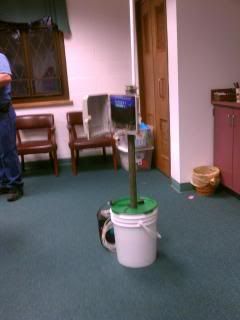



Wednesday, November 16, 2011
Codec 2 Update, Now 1400 bit/s!
There is a great update for the Codec2 project, 1400 bit/s version soon to be released. This is a big step in the right direction. This will make it more useful for digital voice over HF. Check out David's Blog for more information.
www.rowetel.com/blog/
www.rowetel.com/blog/
Thursday, November 10, 2011
Veterans Day 2011
Thanks to all that have served and serving now. Thanks!
HHT 4/11 ACR Fulda Germany
82 ENG Battalion Bamburg Germany
1990-96
Monday, October 24, 2011
FCC warns 20 US online retailers to stop selling signal-jamming devices
The FCC has issued warnings to 20 US online retailers to stop selling illegal signal-jamming devices. These more than 200 uniquely-described models include mobile phone, GPS and Wi-Fi jammers. Enforcement Bureau Chief Michele Ellison said, "Our actions should send a strong message to retailers of signal jamming devices that we will not tolerate continued violations of federal law. Jamming devices pose significant risks to public safety and can have unintended and sometimes dangerous consequences for consumers and first responders."
These signal jammers could hurt more than they were intended to "help". These could cause interference on the ham bands, especially HSMM. Thanks to the FCC for addressing and enforcing the laws for these jamming devices. Please read and stay vigilant with our spectrum.
The full text of the Omnibus Citation and Order is available at: http://hraunfoss.fcc.gov/edocs_public/attachmatch/DA-11-1661A1.pdf
http://www.fcc.gov/document/fcc-cites-online-retailers-marketing-illegal-jamming-devices
These signal jammers could hurt more than they were intended to "help". These could cause interference on the ham bands, especially HSMM. Thanks to the FCC for addressing and enforcing the laws for these jamming devices. Please read and stay vigilant with our spectrum.
The full text of the Omnibus Citation and Order is available at: http://hraunfoss.fcc.gov/edocs_public/attachmatch/DA-11-1661A1.pdf
http://www.fcc.gov/document/fcc-cites-online-retailers-marketing-illegal-jamming-devices
Wednesday, October 12, 2011
PBX in a Flash for Intel Atom Platform
The Intel atom platform does not work well with this version of PBX in a flash. The problem is the CentOS doesn't currently support the Intel Atom motherboard very well. But all hope is not lost, they have a version just for the Intel Atom. I will be looking at this some more in the future. I am also looking at building a barebones computer for this also.
http://atomicflash.org/
http://knol.google.com/k/vpn-in-a-flash
http://atomicflash.org/
http://knol.google.com/k/vpn-in-a-flash
Friday, September 16, 2011
PBX in a flash for HSMM VOIP
I am interested in a VOIP solution for HSMM and I am trying PBX in a Flash out. It looks like a very good setup. When you install it it will over wright your hard drive, this may be a problem to others than me. I want to experiment with it but only have two laptops at this time, I know that is a problem to have. I also want this to be portable and not run on a desktop which is a lot harder to take to the field. So I decided to install it on a flash drive. The flash drive used for this test was a 4GB Cruzer USB 2.0.
It was easy to install, first I downloaded the ISO file from the web site, then I burned it to disk. I then used an extra desktop to burn this to the flash drive. The first thing I did was to disconnect the hard drive to give this software no choice but to install to the flash drive. The default install went smooth, but it did take quite a while to install CentOS. Then it had to load the VOIP software which also took quite a while. After it was installed I ran the program and it did fine. The only problem I have right now is that the drivers for the alternate computer are not setup. There must be a way to go back and update the OS for the next computer it is hooked up to. I will be looking at this and also maybe a DC-DC converter for a desktop unit. There is much to do here but it is very promising.
http://pbxinaflash.net/
Tips and How too's:
http://nerdvittles.com/index.php?p=740
http://www.cadvision.com/blanchas/Asterisk/Passwords.html
It was easy to install, first I downloaded the ISO file from the web site, then I burned it to disk. I then used an extra desktop to burn this to the flash drive. The first thing I did was to disconnect the hard drive to give this software no choice but to install to the flash drive. The default install went smooth, but it did take quite a while to install CentOS. Then it had to load the VOIP software which also took quite a while. After it was installed I ran the program and it did fine. The only problem I have right now is that the drivers for the alternate computer are not setup. There must be a way to go back and update the OS for the next computer it is hooked up to. I will be looking at this and also maybe a DC-DC converter for a desktop unit. There is much to do here but it is very promising.
http://pbxinaflash.net/
Tips and How too's:
http://nerdvittles.com/index.php?p=740
http://www.cadvision.com/blanchas/Asterisk/Passwords.html
Monday, August 29, 2011
Prototype HSMM-Mesh Portable Node
Here is a prototype Mobile mesh node. I built this using a 5 gallon bucket, a military surplus fiberglass pole, and concrete. This was a cheap build because 5 gallon buckets are easy to procure, and the concrete was left over from a fence repair. The fiberglass military poles are found at most hamfests and also online. These poles make good quick antenna masts. I built this with the ability to stack these when they are in storage. I cut the pole at 13 inches and then put it in the middle of the half filled bucket of concrete. Be sure to cut it shorter than the room needed for the top. Make sure your bucket is level and that your mast is also level. I then drilled a hole in the middle of the top to allow the mast to be installed with the top still on. This is how to keep them stackable and not loose the top in the field. I used the rest of the cut off piece and mounted the node on it. This keeps you from wasting anything. I used two other poles and had the node about 12 feet in the air. It was very stable. It could also be guyed in a windy environmet or if you wanted to go higher.
Here are the basic parts to start:
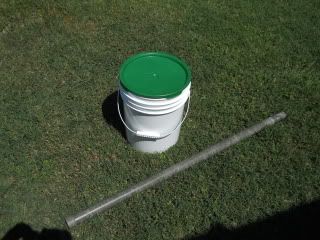
Here is the mast installed and the hole drilled into the top:

Here is how it looks when installed:
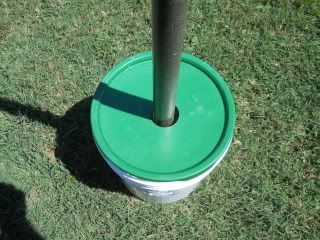
Here is the node at about 12 feet:
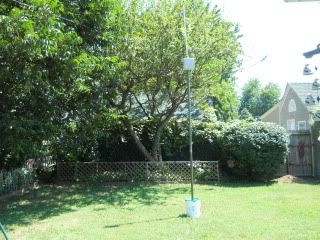
Here are the basic parts to start:

Here is the mast installed and the hole drilled into the top:

Here is how it looks when installed:

Here is the node at about 12 feet:

Friday, August 26, 2011
HSMM Mesh Firmware Version 0.4.2 Release
Updated HSMM-Mesh firmware version 0.4.2 has been released. This updated added features and fixed some bugs. Here is a summary of what has changed:
- fixed the bug which prevented port forwarding a range of ports
- added a waterfall display to the signal strength page
- improved hostname resolution on multi-interface devices
- status page now displays the number of olsrd restarts and how long it has been since the last restart
- olsrd watchdog detects more error conditions
- fixed the "text page of death" on the mesh status page when olsr is not running
- swapped the columns on the mesh status page
- make the txtinfo pugin available to the LAN
- fixed a previous neighbor display bug
Update your software or join and build your own node!
http://hsmm-mesh.org/software-download.html
http://hsmm-mesh.org/images/stories/hsmmmesh-step-by-step.pdf
- fixed the bug which prevented port forwarding a range of ports
- added a waterfall display to the signal strength page
- improved hostname resolution on multi-interface devices
- status page now displays the number of olsrd restarts and how long it has been since the last restart
- olsrd watchdog detects more error conditions
- fixed the "text page of death" on the mesh status page when olsr is not running
- swapped the columns on the mesh status page
- make the txtinfo pugin available to the LAN
- fixed a previous neighbor display bug
Update your software or join and build your own node!
http://hsmm-mesh.org/software-download.html
http://hsmm-mesh.org/images/stories/hsmmmesh-step-by-step.pdf
Battery Power for the Portable HSMM Mesh Nodes
I now have the batteries for the portable Mesh nodes. I will be using the Deka DC27 Marine Master deep cycle battery. These batteries have a nice carry handle built in and also are rated at 200 minute 23 Amp hour. This should be enough to run a node for several days. These can be recharged in the field with a small generator or a vehicle. Now it is time to work out the best way to make the nodes portable and quick to deploy.
http://www.dekabatteries.com/default.aspx?pageid=468
http://www.dekabatteries.com/default.aspx?pageid=468
Tuesday, August 16, 2011
Firefox 6.0 New Release
Mozilla has just released their updated web browser Firefox 6.0. They are saying this version is faster than the last, I hope so. I like Firefox but it has been slow at start up. I will be downloading this and trying it on a Windows and Ubuntu computer.
www.mozilla.org/
www.mozilla.org/
Monday, August 15, 2011
Grandstream GXP-280 HSMM PBX Phone
The Grandstream GXP-280 looks like a good phone to use with the portable PBX system I am working on now. It is a cost effective, but feature filled phone. The web site states that the phone with most 3rd party SIP devices, gateways and leading soft-switch platforms. This phone should preform very good for the HSMM PBX system.
GXP280 Key Features:
128 x 32 pixel graphical LCD with support for multiple languages
1 line appearance with FLASH to handle up to 2 simultaneous calls
3 XML programmable context sensitive soft keys, 3 way conference
High fidelity wideband audio, full-duplex speakerphone with advanced acoustic echo cancellation
Dual switched auto sensing 10/100 Mbps network ports
Automated provisioning for mass deployment, SRTP
http://www.telephonydepot.com/Grandstream-GXP-280
GXP280 Key Features:
128 x 32 pixel graphical LCD with support for multiple languages
1 line appearance with FLASH to handle up to 2 simultaneous calls
3 XML programmable context sensitive soft keys, 3 way conference
High fidelity wideband audio, full-duplex speakerphone with advanced acoustic echo cancellation
Dual switched auto sensing 10/100 Mbps network ports
Automated provisioning for mass deployment, SRTP
http://www.telephonydepot.com/Grandstream-GXP-280
Monday, August 1, 2011
HSMM WebMail Access for Paclink
I now have a Webmail server setup on my Paclink computer. This gives me the ability to connect a served agencies computer through a HSMM mesh link and supply email through a remote portable Paclink RF node. This gateway can use any email client that supports POP and SMTP. This gives me an Apache server that can be used for many other things on the HSMM network in the future. Once I got it setup and running, I found that I really like how it works. This system allows a served agency to have email access without any changes to the agency computers. All you have to do is give the agency a web address and their tactical email address that you set up in the Paclink software. The one good or bad thing is that it does not keep copies of the emails, the agency sending the emails would have to keep there own copies. I think there is a way to keep copies if you buy the upgraded software for Webmail. I am still working with this and building on the simple webmail server. The active ham web site has a good basic start up guide, my installation did not workout the same but it is probably due to software updates.
http://www.winlink.org/
http://www.wampserver.com/en/
http://www.afterlogic.com/download/webmail.asp
http://www.activeham.com/pmwiki.php?n=Main.WebMailAccessToPaclink
http://www.winlink.org/
http://www.wampserver.com/en/
http://www.afterlogic.com/download/webmail.asp
http://www.activeham.com/pmwiki.php?n=Main.WebMailAccessToPaclink
Wednesday, July 27, 2011
Nook Color for HSMM Update
The Nook Color that I posted about earlier is a very nice little computer. I have been working with it more on the web side, I have played with the ebook side and it works very well. It's web browser is nice, but I have to get used to typing on the screen. I had no problems connecting to the AP router going into the Mesh node. The Nook connected to my Paclink email server without any problems. I can send and recieve email from the Nook. This was a fun and easy project.
Monday, July 25, 2011
HSMM-Mesh nodes update
I now have four mesh nodes up and running in various forms from unmodified to portable battery powered node. These have been working great together. I have had no problems with auto association or hopping from node to node. I have been working on connecting these nodes with a mobile server that can connect to Paclink and send Winlink messages via 2m RF. This is a mobile node that can be placed where needed during an event or emergency. This would let a served agency connect to the portable server and using only a web browser have email capabilities. This means that only a web address and password is needed to access the system, no software needs to be installed at the served agency. The next thing for this project is to have HF capability since we do not have enough 144/440 RMS Gateway Nodes in the state, I hope this will change in the future. I will in a future post go into more detail about the mobile Apache server, but initial testing is very favorable.
Saturday, July 23, 2011
Top 10 DIY from Radio Shack survey
Check out the results from the recent Radio Shack DIY blog survey. Ham radio made it into the top ten at number 8! If they listen to the DIYers, we may have great things and parts locally again. Check it out here: DIY
http://blog.radioshack.com/
http://blog.radioshack.com/
Friday, July 22, 2011
Nook Color for HSMM
I have recently acquired a Barnes and Noble Nook Color. This is a very interesting piece of equipment. Out of the box it has many great features other than an Ebook reader. The Nook has a web browser, email, games, and applications. It has WiFi which is a very nice feature, along with the 7 inch color screen. The only thing it does not have that would be nice is a microphone or line in port. I have been looking at the possibility of using this for HSMM. The web browser may be a quick handy way to access the Mesh. There is a way to change the software to Android or even Ubuntu. I will be looking into these in the near future.
http://www.barnesandnoble.com/nookcolor/index.asp
http://www.nook2android.com/
http://www.barnesandnoble.com/nookcolor/index.asp
http://www.nook2android.com/
Wednesday, July 20, 2011
Hand Sending International Morse Code
Here is a good Army video on how to properly send morse code with a straight key. I found it to be good training even for today. So dust off those unused straight keys and practice the original digital mode.
Thursday, June 23, 2011
HSMM-Mesh Internet Tunnel Software Beta Testing Now
The HSMM-Mesh developers are beta testing internet tunneling software. This software will allow remote Mesh networks to link together through the internet. This will be a great leap in capabilities for the software. It will be possible to increase the Mesh network foot print till we can get the gaps filled in. This will be the start of the nationwide mesh network. Here in Henderson Kentucky I have 3 nodes up and running, and we have several hams locally that are building nodes. I would like to link Henderson to the nationwide network. Just think of the possibilities!
http://hsmm-mesh.org/
http://hsmm-mesh.org/under-development/108-virtual-tunnels.html
http://hsmm-mesh.org/
http://hsmm-mesh.org/under-development/108-virtual-tunnels.html
Thursday, June 16, 2011
HF propagation for Firefox Web Browser
Here is a fun add on for the Firefox web browser. It is called Propfire and works with Firefox and will not work with any IE versions. This will keep you informed about the status of the HF bands. Check it out!
http://www.n0hr.com/Propfire.htm
http://www.n0hr.com/Propfire.htm
Monday, May 23, 2011
SCS: New Pactor 4 Modem
SCS has posted a new modem for Pactor 4. The P4dragon DR-7800 is the latest and in the line of pactor modems. This one the say has been redesigned with a fast quad-core DSP allowing high data rates. I am still a fan of software based digital modes like Winmore. It is nice to see advances in communications. Check it out and let me know what you think.
English translation:
http://tinyurl.com/Pactor4SCS
For those that speak German:
http://www.pactor4.com/SCS_DRAGON_DE/Home.html
English translation:
http://tinyurl.com/Pactor4SCS
For those that speak German:
http://www.pactor4.com/SCS_DRAGON_DE/Home.html
Saturday, May 21, 2011
"DIY Community" asked for Input by Radio Shack
The "DIY Community" asked for Input by Radio Shack. This is very interesting but is not unexpected. Maybe they will move back to their roots and have more parts, and other items they had back in the day. It would be nice to have "Radio Shack" brand equipment and maybe even some Ham radio equipment. Be nice but let your voices be heard!
Click here to be heard!
Click here to be heard!
Thursday, May 5, 2011
FEMA Thanks The Amatuer Radio Community
Craig Fugate, FEMA Administrator, at the Earthquake Communications Preparedness Forum, held on Tuesday, May 3, 2011 in Washington, DC, thanked the Amateur radio community. He said that ham radio really is valuable "when all else fails". His part of the forum begins at about 18:30. The whole video was interesting if you have the time to watch, at least watch the part about ham radio. I think this gives some insight about Amateur radio and public service.
http://beta.fcc.gov/event/earthquake-communications-preparedness-forum
http://beta.fcc.gov/event/earthquake-communications-preparedness-forum
Friday, April 29, 2011
DDP an Alternative Protocol for Packet Radio
Danny Knaggs, 2E0DPK is developing a new free Ham protocol. DDP, Danny's Digital Packet, is a new Alternative Protocol for Packet Radio. It works with FLDigi or D-STAR DV. What is different is that the packets are sent and recieved in plain text on the waterfall. This is a very interesting development that will work with several operating systems. This is still Beta, so may the testing begin.
http://code.google.com/p/ddp/
http://code.google.com/p/ddp/
Wednesday, April 27, 2011
PMRC's "Every Single Minute"
Here is a nice old video about Ham Radio. Some of the equipment used brings back a lot of memories of my early ham exposure and experience. I have operated a lot of the boat anchors shown in the video. Please enjoy
Monday, April 25, 2011
Keep your Computer Clock Accurate for the Digital Modes
There is a need to keep your computer clock accurate for some of the digital modes. There are several ways hams have been trying do do this ands some have become outmoded with the newer Windows operating systems. Meinberg NTP for Windows is the way to go. It is free and it is also the "official" Network Time Protocol client software. The only downside to ham software needing this level of accurace is that it probably would not be a good mode in an emergency. There would be no to keep the clocks that accurate without using a GPS signal or something else. How many Hams would be prepared for that? Julian, G4ILO has a good write up about this on his Blog. Check it out and see if you can keep up with time.
http://www.meinberg.de/english/sw/ntp.htm#ntp_nt_stable
http://blog.g4ilo.com/2011/04/time-to-ditch-dimension-4.html
http://www.meinberg.de/english/sw/ntp.htm#ntp_nt_stable
http://blog.g4ilo.com/2011/04/time-to-ditch-dimension-4.html
Saturday, April 16, 2011
NBEMS using FLMSG auto open feature
Here is a nice video that Dave, KB3FXI made of a digital net using the NBEMS, Narrow Band Emergency Messaging Software. The Net Control Station was Ronald, K3MIY. They used MT63 1k long and the FLMSG auto open feature using the NTS/Radiogram form. This is a great way to send Bulletins and NTS traffic via any HF/VHF/UHF digital Net. Check out the video.
Download NBEMS from:
http://www.w1hkj.com/
NBEMS article:
http://wedothatradio.wordpress.com/2008/04/14/nbems/
Download NBEMS from:
http://www.w1hkj.com/
NBEMS article:
http://wedothatradio.wordpress.com/2008/04/14/nbems/
Wednesday, April 13, 2011
More Information on Gemlink
I sent one of the Gemlink units to Steve, KB9MWR to look at. Steve has done an excellent job of documenting this unit. I must also include Joe, N9ZIA, who is responsible for this great write up. Sorry I missed giving credit to him originally. The Gemlink uses the K Band, the Ham part of this band is 24Ghz. I am not sure if the Gemlink equipment can be tuned and used on the Ham bands. I do not have the equipment that will work at this frequency. I am looking for some equipment, so that I can experiment with this system. Check out the write up about it.
http://www.qsl.net/n9zia/gemlink/index.html
http://www.qsl.net/n9zia/gemlink/index.html
Wednesday, April 6, 2011
Henderson Kentucky Digital Working Group
Here in Henderson KY, we have started a digital working group. We will be working towards learning, teaching and developing digital systems. We have 11 members in this group to start with. We had our first meeting and everyone is excited to move forward with HSMM. We will be using WRT54G's and HSMM-Mesh software to build several portable nodes so that we can deploy them and do some testing on a larger scale. We will start small and build this into the complete system with RMS/BBS/BPQ32 capabilities. We will be building the first simple nodes to the same basic standard specifications to help everyone to be able to use and setup any portable node without problems. We will also be using the same software throughout the system. I think we will have some nice deployments this summer in some of the local parks and we will have to bring some food to grill. Here are a couple of pictures of the first meeting:
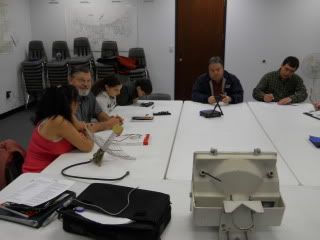
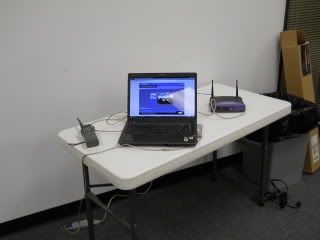


Tuesday, April 5, 2011
Acer Aspire One D250-1842 10.1" Netbook
I just recently bought a used Acer Aspire One Netbook. My first impressions with this netbook is that it is small and compact but still powerful enough to run the software I need to. The keyboard is of course on the small side for my big hands but as long as I do not type to fast it works fine. It has Windows 7 Starter which will give me some experience with the newer Windows operating system. I am not impressed so far. It is so different from any of the other operating systems I have used. I am used to XP which is probably my favorite Windows system. Linix Ubuntu is starting to be my favorite now. It would be nice to be able to change the look and feel to an XP look, but I am not sure that will be possible. I think it will be a good additional laptop for HSMM and other digital modes. I did have it on the air and ran FLdigi last night without any problems. All in all it will be an interesting learning experience.
Some specifications for the netbook:
Screen Size 10.1"
Display Screen Type Active Matrix TFT Color LCD
Memory 1 GB
Lithium Ion Battery
Wi-Fi Standard IEEE 802.11b/g
Ethernet Technology Fast Ethernet
Weight (Approximate) 2.80 lb
Height 1"
Width 10.17"
Depth 7.24"
Hard Drive Capacity 250 GB
Processor Speed 1.60 GHz
Processor Type Atom
Processor Model N270
Processor Manufacturer Intel
Operating System Windows 7 Starter
Some specifications for the netbook:
Screen Size 10.1"
Display Screen Type Active Matrix TFT Color LCD
Memory 1 GB
Lithium Ion Battery
Wi-Fi Standard IEEE 802.11b/g
Ethernet Technology Fast Ethernet
Weight (Approximate) 2.80 lb
Height 1"
Width 10.17"
Depth 7.24"
Hard Drive Capacity 250 GB
Processor Speed 1.60 GHz
Processor Type Atom
Processor Model N270
Processor Manufacturer Intel
Operating System Windows 7 Starter
Thursday, March 24, 2011
Firefox 4 and IE9
I have been looking at the new Internet Explorer 9 and the new Firefox 4 internet browsers. I have to say that after what I have seen and heard I will be going with Firefox 4. Jillian, G4ILO, has an entry on his Blog about this very subject, see it here. I liked the older Internet Explorer's, they were simple and useful to me. The new IE9 is to integrated with everything. I am probably too old school on this subject. The Firefox browser is nice but it has some problems also. It seems to take longer to transition to Web pages. It also has the buttons at the top in different places, so it takes some getting used to. All in all I will be transitioning to Firefox 4. Firefox is easy to install and does not cause a bunch of trouble upgrading. Try it out and let me know what you think.
www.mozilla.com
www.mozilla.com
Monday, March 21, 2011
1439 Miles on 2.4 GHZ Across the Tasman Sea
It looks like Steve Hayman, ZL1TPH, and Adrian Pollock, VK4OX have set a new record for 13 Centimeters. It was for 1439 Miles on 2.4 GHz for the first trans-Tasman Sea contact. This is a great feat since this band is considered line of sight!
For more information: http://www.arnewsline.org/index.php?option=content&task=view&id=145
For more information: http://www.arnewsline.org/index.php?option=content&task=view&id=145
Friday, March 18, 2011
WinDRM Digital Voice
WinDRM is a sound card program for digital voice and sending pictures. The software uses DRM, Digital Radio Mondiale, modified by Cesco, HB9TLK, for Ham radio. The minimum requirement is a 1 GHz computer running Windows 2000 or higher and one or two sound cards. It is recommended to use two sound cards with digital voice, as cheap as a usb sound card is, it should not be a problem to run two. DRM is open source software, and I do like open source! I have been playing with the software and when time permits I will try to use on the air. There is very good instructions on Jason, N1SU, site. If you have used this software, let me know what you think about it.
http://n1su.com/windrm/download.html
http://n1su.com/windrm/WinDRM_QuickSetupV1r1.pdf
http://n1su.com/windrm/download.html
http://n1su.com/windrm/WinDRM_QuickSetupV1r1.pdf
Tuesday, March 8, 2011
Spread Spectrum Rules Changes
FCC Adopts Spread Spectrum Rules Changes
In a Report and Order adopted February 22 and released March 4, 2011, the Federal Communications Commission has eliminated the requirement that amateur stations transmitting Spread Spectrum use Automatic Power Control (APC) to reduce transmitter power. At the same time, the Commission has reduced the maximum power of a Spread Spectrum emission from 100 to 10 W PEP.........
For more information: http://www.arrl.org/news/fcc-adopts-spread-spectrum-rules-changes
This will have some effect on HSMM some good and some not so good. It is a good thing to do away with the automatic power control rule, but the 10 W PEP will hopefully be looked at more in the future. The power limitation is not a huge problem now but will limit some of the experimentation in the near future.
Monday, February 21, 2011
Memories from a box
I had a flashback in time last night when I took the trash to the curb. My wife had been in the attic and emptied an old box and then set the box out for me to get rid of. This box was from the first PC computer I ever bought that ran Windows. I bought this computer when I was stationed in Fulda Germany in the early 90's. What is hard to believe is that it has been nearly 20 years ago and only seems like it was just yesterday! Wow does time fly! But of course if I stop and think about it my kids have kids now so I guess I qualify as an old timer. This computer was the fastest one I ever had, it had to of had lightning in it!
AST Advantage! Plus
486DX/33 Model 348
-340 MB Hard Drive - 4 MB RAM
-1.2MB and 1.44MB Floppy Disk Drives
-Local Bus VGA 1 MB Memory
-AST Enhanced Keyboard - AST Two-Button Mouse
-Lotus 1-2-3 for Windows and Ami Pro
-Prodigy - American OnLine
-Fax Modem - WinFax
This is the computer that got me hooked to Windows, of course it was a different animal back then. Only lately have I veered away and started using Linux. What memories a box will bring to you.
AST Advantage! Plus
486DX/33 Model 348
-340 MB Hard Drive - 4 MB RAM
-1.2MB and 1.44MB Floppy Disk Drives
-Local Bus VGA 1 MB Memory
-AST Enhanced Keyboard - AST Two-Button Mouse
-Lotus 1-2-3 for Windows and Ami Pro
-Prodigy - American OnLine
-Fax Modem - WinFax
This is the computer that got me hooked to Windows, of course it was a different animal back then. Only lately have I veered away and started using Linux. What memories a box will bring to you.
Wednesday, February 16, 2011
GEMLINK Microwave Equipment
I have acquired a lot of Gemlink microwave equipment. I have many, many different parts and a lot of the dish receiver/transmitter. These are all on 23Ghz commercial band, so I think they should be able to be tuned to the Ham bands. I will be posting more about this stuff as I go through it. I am looking for any information on this equipment and anyone that has worked with any of this system. I have a LSD-122A bi-directional unit for data and voice and one I think was used for one way video. Here are a couple of pictures:

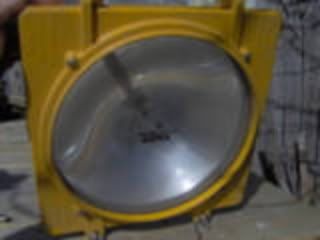


Sunday, February 13, 2011
Truck load of Microwave Equipment
I just picked up a Truck load of early microwave equipment and books along with some other goodies. The Ham I got these from was not active any more and needed to clean out his shack to move into a smaller home. He was an early pioneer in microwave technology with General Electric. I have only started to look through this equipment and WOW! I have a lot of stuff I will have to research. I have what looks like a working feed horn Display from 1961. I also have a lot and mean a lot of Gemlink equipment. This will be interesting to find out if it can be used on the Ham 24 GHz band. More about this later, for now take a look at these pictures.




Wednesday, February 9, 2011
Ham Radio and the Future
I have been hearing a some complaining from some hams that have a problem with using the Internet to link stations. I have also had several complain about why do we need digital modes we have CW and thats all we need. I would prefer to have a backup link using RF, but that is not always possible when you are first setting up packet/Winlink nodes. The infrastructure is just not there and will take some time to build it. So by using the Internet to link nodes helps get remote nodes connected and to show others that the system does work. Then as more see the system as being viable, we can add more stations and also the RF backbone. In the end the Internet would not be needed to use the system. I also think CW is a great and needed mode but I wonder what ever happened to the real hams that used a spark to send his traffic?
I am not putting down any CW operators, but some of the attitudes towards anything new is not helping the hobby. This hobby has many different things to experiment with, from CW, AM, SSB, Digital, Satellites and many others. We need to have an attitude for the hobby of "That mode does not interest me, but I am glad you are advancing the Radio Arts." If we all looked at it this way maybe we could advance the Radio Art. We need to promote all modes in the hobby and computers are here to stay. Also, a future Ham only Mesh Network needs to move forward. Thanks for bearing with my rambling rant on this subject. 73
I am not putting down any CW operators, but some of the attitudes towards anything new is not helping the hobby. This hobby has many different things to experiment with, from CW, AM, SSB, Digital, Satellites and many others. We need to have an attitude for the hobby of "That mode does not interest me, but I am glad you are advancing the Radio Arts." If we all looked at it this way maybe we could advance the Radio Art. We need to promote all modes in the hobby and computers are here to stay. Also, a future Ham only Mesh Network needs to move forward. Thanks for bearing with my rambling rant on this subject. 73
Friday, February 4, 2011
BPQ32 AXTCP Works fine
Here in Kentucky we have had to use something to connect the EOC's with BBS traffic. In the EOC's we could not open ports. We do not have an RF backbone setup yet(this is the next step in the list). We used AXTCP to connect the Owensboro EOC to my node in Henderson and it worked great! Thanks John! This works fine for the BBS and Chat. This will let us get the nodes in the EOC's while we work on building the rest of the network for the backbone. I will be setting up in February the Henderson EOC and it will be setup with a 440 9.6k port for the backbone. We will start with 440 but I would like to use another frequency but we have to start somewhere. Again, I have to say BPQ32 is the software for any serious node work.
Tuesday, February 1, 2011
Software Based PBX for Windows Based Systems
3CX Phone System is a free Voip PBX / SIP server software for Windows. This is an iteresting piece of software that may have some possibilites for using with a HSMM mesh system. I have not tried it yet but have been looking into it and so far have many thoughts about testing it on my small mesh network. It uses popular IP Phones such as Polycom, Snom, Cisco & others or Softphones. I like what i have seen with the documintation on their softphone and like the posibilites with it. It also runs on Microsoft Windows so no need to learn Linux if you did not want to. The software is a full edition is a fully functional product. To see which Windows systems are supported go here: http://www.3cx.com/blog/docs/supported-windows-versions This could be very usefull with HSMM, if anyone has tried it let me know what you think. Check out these other links for more info:
http://www.3cx.com/products/products-info.html
http://www.3cx.com/phone-system/3CXPhoneSystem_brochure.pdf
http://www.3cx.com/VOIP/voip-phone.html
http://www.3cx.com/forums/
http://www.3cx.com/products/products-info.html
http://www.3cx.com/phone-system/3CXPhoneSystem_brochure.pdf
http://www.3cx.com/VOIP/voip-phone.html
http://www.3cx.com/forums/
Wednesday, January 26, 2011
New release of JT65-HF
W6CQZ has a new release out for JT65-HF for terrestrial use. JT65-HF 1.0.7 is the latest version. This mode is an adaptation of the JT64A protocol. I have not tried this mode yet, but it looks very interesting. Check it out:
http://sourceforge.net/projects/jt65-hf/files/
http://sourceforge.net/projects/jt65-hf/files/
Sunday, January 23, 2011
Amateur Radio Codec2 Video
Here is a nice video with Paul ZL3IN and Bruce Robertson VE9QRP have a nice conversation using codec2. This is what I think Amateur radio is all about. Open source and moving in the direction we need. Check it out and see what you think. I think this a better route than D-Star. I have never embraced D-Star as a true Amateur Radio mode. Should I look into it more or stand my ground on D-Star. Watch the video and then let me know.
Codec2 Yahoo Group
http://groups.yahoo.com/group/Codec_2/
The Codec2 Project
http://codec2.org/
Codec2 Yahoo Group
http://groups.yahoo.com/group/Codec_2/
The Codec2 Project
http://codec2.org/
Monday, January 17, 2011
BPQ32 Now With Winlink2000 CMS Telnet Capabilities
I have been playing with BPQ32 for some time and have really liked it so far. Now it even surpasses all my expectations, I am not sure how John Wiseman GM8BPQ/G8BPQ does it, but he does! This new version includes CMS telnet access via the BPQ32 program. There is no need to run separate Winlink software to run a RMS Node. I have been testing this new configuration and have had no problems yet. It is also easier to setup than it ever has been. This software does not need the NET 3.5 that the RMS program needs, thus limiting you to Windows XP or newer. BPQ32 should be able to run on Windows 2000. I have not tested it yet but am planning on testing it on a 2000 machine in the near future. There is also included reporting to the Winlink Packet Station Database. Now we only need one program to do most of the work. Check it out
http://groups.yahoo.com/group/BPQ32/
http://www.cantab.net/users/john.wiseman/Documents/TelnetServer.htm
http://www.cantab.net/users/john.wiseman/Documents/WL2KReporting.html
http://groups.yahoo.com/group/BPQ32/
http://www.cantab.net/users/john.wiseman/Documents/TelnetServer.htm
http://www.cantab.net/users/john.wiseman/Documents/WL2KReporting.html
Tuesday, January 11, 2011
HSMM-Mesh Upgrade 0.4.1 Firmware
I have been playing with HSMM-Mesh and have upgraded to their newest firmware and find it operates wonderful! A news release from their site: http://hsmm-mesh.org/news.html
http://hsmm-mesh.org/
"The time has come for a firmware update. This is primarily a bug fix release. It is available as both a full firmware image (as it always has been) and also as a patch. This is the first time that a patch has been released, so this upgrade will be easier than in all prior releases.The HSMM-Mesh Upgrade 0.4.1 Firmware has been real fun to play with. These guys are moving right along with the HSMM-Mesh firmware. I have three WRT54G routers setup and running. I have had one outside in a weatherproof box running since November using the 0.4.0 firmware. It has been down into the teens and I have had no problems yet. I will be field testing / demo the system in the spring. Go to their site and check it out.
This patch will require that the node be rebooted and that will happen automatically during the installation. To install it make sure your node has internet access and go to the Administration page, click Refresh in the Download Firmware section, select patch-0.4.1.tgz and click Download. That's it, in a few moments you will have new firmware!
Here is a summary of the updates:
- fixed the average signal strength reading
- fixed an olsr bug which caused it to crash
- fixed a DMZ mode configuration bug when the WAN was disabled
- improved the firewall handling when a DMZ server is used in NAT mode
- improved the calculation of the Previous Neighbors age
- do not display local network details to remote nodes
73
ad5oo"
http://hsmm-mesh.org/
Monday, January 10, 2011
How you know when it's time to switch to Linux
I have been using Linux Ubuntu 10.10 for a while now. I am really getting to like it more and more. I would like some of the more of the ham software work on linux, of course maybe I need to learn some more about the OS. I have been reading and working with the command line and this has been a fun learning experience. I found a nice article about when is it time to switch to Linux, so I have linked it here. Take a look at the article it has some good points.
http://blogs.computerworld.com/17588/how_you_know_when_its_time_to_switch_to_linux?source=CTWNLE_nlt_linux_2011-01-04
http://blogs.computerworld.com/17588/how_you_know_when_its_time_to_switch_to_linux?source=CTWNLE_nlt_linux_2011-01-04
Wednesday, January 5, 2011
HSMM and Wireshark Network Tool
There are many helpfull software utilities to help with HSMM. I have found a good network "sniffer" in Wireshark. Wireshark is free and will run on Windows or Linux. When you run this software, you choose which network interface on your computer to use and then it will display and log every packet that is transmitted or recieved on your network interface. This is a great program to learn about what happens on a network. It will also help to debug problems on your network. This software is a good thing to have in your HSMM toolbox. Try it out.
http://www.wireshark.org/
Monday, January 3, 2011
The invisible Ubiquiti bullet 2hp
I had some time over the New year weekend to play with my ubiquiti bullet 2hp. I have had this for a while but have not had time to play with it. I wish I had played with it sooner, it is great! This is a nicely built piece of equipment. I used a POE adapter like I use on the WRT54G and a 12db omni antenna. It preformed nice. It showed up strong on my inssider wifi software. The best thing I liked about the bullet was the slide band capabilities. I was using the stock firmware and it has the capability of changing the center frequency to one not used by traditional routers. This gave me an invisible radio, if you can't see it you would not even try to hack it! When I switched it over to an odd frequency it just diapered from my wifi software screen. Maybe with some good mesh software we could setup a mesh network that would be invisible to everyone else. My next project is to find and test some software that will give the bullet mesh capabilities.
http://ubnt.com/bullet
http://www.metageek.net/products/inssider
http://ubnt.com/bullet
http://www.metageek.net/products/inssider
Subscribe to:
Posts (Atom)